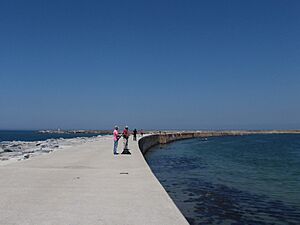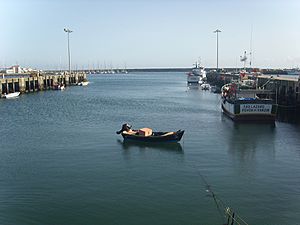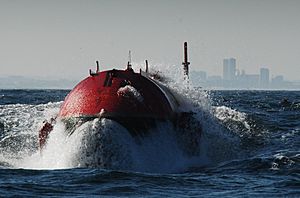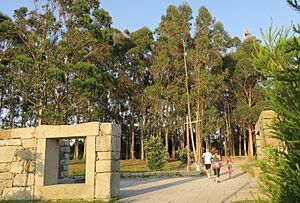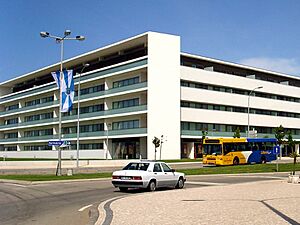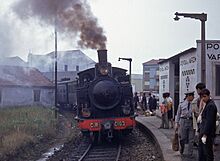Póvoa de Varzim facts for kids
Quick facts for kids
Póvoa de Varzim
|
|||
|---|---|---|---|
|
Municipality
|
|||

Clockwise from top: Nova Póvoa, Rua Santos Minho, Touro, the City Park, Lagoa Beach, Senhora das Dores Church, and Praça do Almada.
|
|||
|
|||
| Country | |||
| Region | Norte | ||
| Metropolitan area | Porto | ||
| District | Porto | ||
| Established | Roman settlement: c. 138 BC Municipal charter: 9 March 1308 |
||
| Area | |||
| • Total | 82.1 km2 (31.7 sq mi) | ||
| Elevation | 190 m (620 ft) | ||
| Highest elevation | 202 m (663 ft) | ||
| Lowest elevation | 0 m (0 ft) | ||
| Population
(2021)
|
|||
| • Total | 64,320 | ||
| • Density | 783.4/km2 (2,029.1/sq mi) | ||
| Time zone | WET/WEST (UTC+0/+1) | ||
| Postal code |
4490-000 — 4490-999, 4494-909, 4495-001 — 4495-613, 4496-903, 4750-010 — 4750-554
|
||
| Area code | 252 | ||
| Local holiday | 29 June | ||
Póvoa de Varzim is a city in Northern Portugal. It is about 30 kilometers (19 miles) from the center of Porto. The city is on a sandy coast, between the Minho and Douro rivers. In 2021, about 64,320 people lived here. It is one of the largest urban areas in Northern Portugal.
People have lived in Póvoa de Varzim for thousands of years. Around 900 BC, a fortified city called Cividade de Terroso was built. It traded with ancient civilizations. After the Romans arrived in 138 BC, fishing and fish processing became very important. This helped the local economy grow. By the 11th century, fishing and farming were key to the area. Póvoa de Varzim became a municipality in 1308.
During the Age of Discovery, the city became important again. Its shipbuilders and merchants traded all over the world. By the 17th century, Póvoa de Varzim was the main fishing port in northern Portugal.
For over 300 years, Póvoa de Varzim has been a popular beach resort. It is known for its beautiful sandy beaches and its lively culture. The Casino da Póvoa is a famous place for entertainment. Visitors also enjoy the traditional Junqueira shopping street, Garrett Theatre, and the Ethnography and History Museum. You can also visit ancient sites like Cividade de Terroso and the medieval Rates Monastery. The city is famous for its delicious Portuguese cuisine, especially seafood. Póvoa de Varzim also has important textile and food businesses. The city has kept its unique cultural identity and old traditions, like the siglas poveiras writing system and the masseira farming method.
Contents
- Discovering Póvoa de Varzim's Past
- Exploring Póvoa de Varzim's Nature
- People of Póvoa de Varzim
- Póvoa de Varzim's Economy
- City Life and Landmarks
- Culture and Fun in Póvoa de Varzim
- Public Services for Everyone
- Getting Around Póvoa de Varzim
- Famous People from Póvoa de Varzim
- Póvoa de Varzim and the World
- See also
Discovering Póvoa de Varzim's Past
Ancient Times: From Stone Age to Roman Rule
People have lived in Póvoa de Varzim since the Stone Age, about 200,000 years ago. The first shepherds settled on the coast around 4,000 to 2,000 BC. You can still see ancient burial mounds around São Félix Hill and Cividade Hill.
Around 900 or 800 BC, people built a fortified city called Cividade de Terroso on a hill near the sea. This city was protected by walls and a trench. It traded with civilizations around the Mediterranean Sea.
The Romans arrived in the region around 138 BC. They conquered Cividade de Terroso, leaving it in ruins. After the area became peaceful under Roman rule, people moved back to the coast. Roman fish factories were built, and trade helped the local economy grow.
Medieval Times: From Feudal Lords to a New Town
After the Roman Empire fell, new groups settled in the area. Póvoa de Varzim was first mentioned in 953 AD. It was attacked by Vikings and Moors in the 10th and 11th centuries. Some hints suggest Norse people settled here after these attacks. The name Euracini slowly changed over time to Varzim.
In 1033, a powerful leader named Guterre Pelayo became the Lord of Varzim. Later, the early Portuguese kings and local lords fought over control of the area. This led to the creation of the modern municipality in 1308. King Denis gave a special charter, called a Foral, to 54 families in Varzim. They were to create a new town called Póvoa (meaning "settlement") around a central square.
In 1514, King Manuel I gave Póvoa de Varzim a new charter. This gave the town more self-government. It also became involved in the Portuguese discoveries, a time when Portugal explored new sea routes.
Golden Age: Shipbuilders, Sailors, and Fishermen
By the 16th century, the fishermen of Póvoa were skilled sailors. They worked as pilots and crew members on Portuguese ships. Povoan shipbuilders were also very famous for their skills. They built ships for trade and fishing.
In the 17th century, shipbuilding grew even more. About a third of the people in town worked in this industry. The town also expanded, with new buildings and a lively fishing neighborhood called Junqueira.
In the 18th century, the focus shifted back to fishing vessels. The fishing community grew rapidly and became very important. Póvoa became known for its expert fishermen. The town became wealthier. In 1791, a new plan for the town was made. New streets, buildings, and a city hall were built. This also opened the way for a new business: sea bathing.
Modern City: A Popular Beach Resort
Since 1725, people came to Póvoa to take sea baths. The iodine-rich seawater was believed to help with skin and bone problems. In the 19th century, Póvoa became a popular summer spot for wealthy people from Portugal and Brazil. The city developed theaters, hotels, and casinos. It became known for its literary culture and arts.
A sad event happened in 1892 when a storm wrecked seven fishing boats, killing 105 fishermen. This deeply affected the community. Over time, the fishing industry became less important. Póvoa grew into the most popular holiday destination in northern Portugal. The textile and food industries also became strong.
Modern transportation arrived with Streetcars in 1874 and a rail connection to Porto in 1875. New highways also linked the city to other towns. All these changes led to a big growth between the 1930s and 1960s. Today, Póvoa de Varzim is a modern city focused on services and tourism. It is a key urban center in Northern Portugal.
Exploring Póvoa de Varzim's Nature
Land and Coastline
Póvoa de Varzim covers an area of about 82.1 square kilometers (31.7 square miles). It is located on the northern coast of Portugal, between the Cávado and Ave rivers. To the north, it borders Esposende, and to the south, Vila do Conde. To the west, it has a long coastline on the Atlantic Ocean.
Unlike areas further north, Póvoa de Varzim has sandy beaches instead of rocky cliffs. The coastal land is mostly sandy. Sand dunes formed along the northwestern coast. Cape Santo André is a notable point on the coast.
Two hills, São Félix Hill (202 meters or 663 feet) and Cividade Hill (155 meters or 509 feet), rise above the flat landscape. They are easy to spot from a distance. The Serra de Rates mountain chain divides the municipality into two parts: the coastal plain and the hillier inland areas with more forests.
There are no large rivers, but many small streams flow through the area. The land is well-watered, and springs and wells are common.
Plants and Animals
Forests are important in the areas around Serra de Rates. You can find maritime pines, oaks, and eucalyptus trees. In the past, the Atlantic forest covered the area with trees like oaks, ash trees, and hazels.
The rocks along the coastline are home to many small sea creatures, fish, and seaweed. These rocks and sand dunes create rich environments for plants and animals.
Short-beaked common dolphins are often seen near Póvoa de Varzim. They sometimes swim alongside boats, looking for discarded fish. Other dolphins, like Risso's dolphin and the Atlantic bottlenose dolphin, also live in these waters.
Weather and Climate
Póvoa de Varzim has a mild climate, influenced by the Atlantic Ocean. Summers are gentle, and winters are mild. Average temperatures are around 9°C (48°F) in winter and 19°C (66°F) in summer. The beach areas have very small temperature changes throughout the day.
It rarely gets very cold, and snow is very uncommon. Most rain falls in the winter months. Summers are usually dry because of the Azores High, a weather system that brings clear skies.
The city often experiences a special kind of fog in summer. This fog covers only the coast and carries a strong ocean smell. This is due to warm, wet air from the sea. Póvoa de Varzim gets a lot of sunshine, especially from April to September.
People of Póvoa de Varzim
| Historical population | ||
|---|---|---|
| Year | Pop. | ±% |
| 1720 | 1,396 | — |
| 1736 | 1,796 | +28.7% |
| 1750 | 2,184 | +21.6% |
| 1768 | 3,360 | +53.8% |
| 1780 | 3,776 | +12.4% |
| 1795 | 4,328 | +14.6% |
| 1801 | 4,676 | +8.0% |
| 1821 | 5,672 | +21.3% |
| 1830 | 6,097 | +7.5% |
| 1836 | 8,036 | +31.8% |
| 1849 | 15,300 | +90.4% |
| 1864 | 18,704 | +22.2% |
| 1878 | 20,578 | +10.0% |
| 1890 | 23,372 | +13.6% |
| 1900 | 24,527 | +4.9% |
| 1911 | 25,083 | +2.3% |
| 1920 | 25,929 | +3.4% |
| 1930 | 28,780 | +11.0% |
| 1940 | 31,693 | +10.1% |
| 1950 | 37,938 | +19.7% |
| 1960 | 40,444 | +6.6% |
| 1970 | 42,698 | +5.6% |
| 1981 | 54,248 | +27.1% |
| 1991 | 54,788 | +1.0% |
| 2001 | 63,470 | +15.8% |
| 2011 | 63,408 | −0.1% |
| 2021 | 64,320 | +1.4% |
| Before 1849, data refers only to Póvoa de Varzim Parish (N.S. Conceição). 1720–1836 Sources: 1864–2001, | ||
Someone from Póvoa de Varzim is called a Poveiro. In 2001, there were 63,470 people living in the municipality. Over 38,000 of them lived in the city itself. If you include nearby areas, the urban population reaches about 100,000.
The city's population density is high in urban areas. During summer, the number of people in the city triples as visitors come for the beaches. Póvoa de Varzim is known for having a younger population compared to other cities in the region.
Póvoa de Varzim is a diverse city today. Many people from other parts of Portugal moved here in the 20th century. There are also people from Galicia, Angola, and Mozambique. In recent years, more people from Brazil, China, Ukraine, and other European countries have moved to Póvoa de Varzim.
The population of the whole municipality grew by 15.3% between 1991 and 2001. The urban area has continued to grow steadily in the 21st century. Many new residents come from nearby cities like Guimarães, Famalicão, Braga, and Porto. Foreigners, especially from France and Switzerland, also choose Póvoa de Varzim as a place to live.
Historically, the fishing community of Póvoa had a unique identity. Some studies suggest they might have had Nordic ancestors. They were known for their distinct appearance and traditions. Many Poveiros have moved to other places, like Brazil, South Africa, and Canada, but they often keep strong ties to their hometown.
Póvoa de Varzim's Economy
Póvoa de Varzim's economy relies on sales, manufacturing, construction, healthcare, agribusiness, fishing, and tourism. The unemployment rate in 2021 was 8.3%, which is similar to the national average.
Between 2009 and 2020, the city's economy changed. Some areas like construction and entertainment became less active. However, other areas like real estate, industry, sales, agribusiness, healthcare, and tourism grew a lot.
Fishing and Sea Products
Being a seaside city, fishing has always been important. This includes fishing boats, fish canning factories, and the city's fish market. Seaweed gathering for farm fertilizer was also common. While tourism is now more important, fishing still plays a role. The amount of fish caught here is very high compared to other ports. A Poveira is a traditional canning factory that exports most of its high-quality canned fish.
Fish farming also takes place here. Companies use modern methods to raise valuable seafood like soles.
Farming and Food
Farming in Póvoa de Varzim focuses on vegetables. Many traditional masseiras (special farming plots) have been replaced by greenhouses. A lot of the produce is exported to other European countries. The region is also known for Vinho Verde wine, though local masseira wines are not sold commercially.
The inland areas are important for milk production. A large dairy company, Lactogal, has its headquarters here. The unique masseira farming technique helps grow crops in sand dunes. This method uses sunken plots with raised banks. Grapes grow on the banks, and trees act as windbreaks.
Tourism and Leisure
Tourism is a big part of Póvoa de Varzim's economy. It includes gambling, hotels, restaurants, and beach bars. Many visitors are from Portugal, but more and more international tourists are coming.
The number of hotel rooms has increased. International tourists now make up a large portion of guests. Póvoa de Varzim is becoming known worldwide as a great place for family vacations. People love the sandy beaches, sunsets, and relaxing atmosphere. Walking along the beach promenades and shopping on Junqueira street are popular activities. The city is also famous for its seafood and barbecued chicken restaurants.
The city is working to attract tourists all year round, not just in summer. They do this by promoting sports and cultural tourism.
Manufacturing and Industry
Póvoa de Varzim has industrial areas on its outskirts. The city is known for its Renewable energy industry. The world's first commercial wave farm was located here, testing machines that turn ocean waves into energy. Another project tested offshore wind farms.
Manufacturing is a big employer, especially in the textile industry. Tapetes Beiriz are famous handmade rugs produced here since 1918. The clothing industry also makes luxury clothing and special uniforms.
City Life and Landmarks
City Layout and Neighborhoods
Póvoa de Varzim is located on a coastal plain. The city has eleven main parts, or districts. These districts are part of two larger administrative areas called civil parishes. The city is growing southwards, connecting with Vila do Conde.
The city started inland and then grew towards the coast. The Bairro da Matriz is the oldest part, with narrow, winding streets and old houses. The fishing district, Bairro Sul, developed on the south coast with streets parallel to the sea.
The City Centre is busy with shops and services. Praça do Almada is the main square, with the City Hall and banks. In the middle of the square is the Manueline pillory, a national monument from 1514 that shows the city's independence.
Bairro Norte is the beach district, with many buildings. Next to it is Agro-Velho, also known as Nova Póvoa. This area has many tall buildings, including the Nova Póvoa, which was once the tallest building in Portugal.
Inland, you'll find areas like Giesteira and Argivai. Argivai is divided by the Santa Clara Aqueduct, a very long aqueduct built in 1626. Other older areas like Mariadeira and Regufe are mostly residential. The Regufe Lighthouse is a symbol of the Regufe Quarter. Aver-o-mar is the northernmost coastal district, with a strong fishing character in areas like Santo André.
The city has many beautiful churches. The 18th-century Baroque churches, like the Parish Church and the Church of Our Lady of Sorrows, are very noticeable. The Lapa Church, built by fishermen, even has a lighthouse!
Beaches and Green Spaces
Póvoa de Varzim has a 7.5-kilometer (4.7-mile) stretch of golden sandy beaches. Many city beaches, like Redonda and Lagoa Beach, are popular with families. Beaches further from the city center, like Santo André, are less crowded. Salgueira and Aguçadoura are great for surfing.
The most important green space is the Póvoa de Varzim City Park. This large park has hills, a lake, and streams. It's a popular spot for jogging, cycling, and birdwatching. The park was designed by a famous Portuguese landscape architect.
Other smaller parks and gardens can be found around the city. The Primary Dune System on the northwestern coast is a protected area with boardwalks for walking. The Port of Póvoa de Varzim is also a popular place for walks. Cividade de Terroso is an archaeological site surrounded by green areas. São Félix Hill offers amazing views of the city and countryside.
Countryside Villages
The green belt around Póvoa de Varzim includes many small villages. These include Aguçadoura, Amorim, Balazar, Beiriz, Estela, Laundos, Navais, Rates, and Terroso.
Terroso, Amorim, and Beiriz are close to the city. Beiriz is known for its traditional carpets and old country estates. Amorim is famous for its warm, freshly baked bread. The hills of Cividade and São Félix are in Terroso and Laúndos. Cividade Hill has the ancient city of Cividade de Terroso. Saint Félix is believed to have lived on São Félix Hill long ago.
Rates was a small town in the Middle Ages. It grew around a monastery built in 1100 AD. The São Pedro de Rates Church is one of Portugal's oldest and best-preserved Romanesque monuments. Nearby, Balazar became a Christian pilgrimage site in the 20th century because of Alexandrina Maria da Costa, a mystic who was beatified by the Pope.
The northern sandy areas, like Aguçadoura, Navais, and Estela, are farming regions. They supply vegetables to European markets. These areas also have old legends about magical springs.
Culture and Fun in Póvoa de Varzim
Junqueira is Póvoa de Varzim's busiest shopping area. It has been a shopping street since the 18th century and became a pedestrian area in 1955. It's known for its boutiques and jewelry shops. Ourivesaria Gomes is a famous goldsmith shop that has served important people for over 100 years.

Póvoa de Varzim celebrates many festivals each year. The biggest is Póvoa de Varzim Holiday, dedicated to Saint Peter on June 29. Neighborhoods are decorated, and people gather in the streets for lively rusgas (carnival parades). It's like a big competition between the different parts of the city! Families from all over the world come back for this exciting festival. Easter Monday is also celebrated with family picnics in the woods.
Carnival is another traditional festival. People used to have big balls and parades. Now, the "Spontaneous Carnival" on Avenida dos Banhos attracts thousands of people who gather for an unplanned parade.
Póvoa de Varzim's waterfront is a popular place for fun and nightlife. Avenida dos Banhos has nightclubs, bars, and outdoor cafes. Passeio Alegre is a beach square with more cafes.
The city has a rich history with writers. Many famous authors, like Eça de Queiroz (who was born here!), spent time in Póvoa de Varzim. Today, the city hosts Correntes d'Escritas, a big literary festival where writers from Portuguese and Spanish-speaking countries gather.
Entertainment and Arts

Casino da Póvoa is a major entertainment spot with games, bars, a theater, and restaurants. It's one of the most popular casinos in Portugal. The city also has many hotels, including the historic Grande Hotel da Póvoa from the 1930s.
Póvoa has a long tradition of theater, dating back to 1793. The Teatro Garrett (1873) is a famous theater here. The Varazim Teatro group promotes local drama. The Póvoa de Varzim Auditorium is home to the local music school and the Póvoa de Varzim Symphony Orchestra. The city also hosts an international music festival.
The Póvoa de Varzim Bullfighting Arena is used for bullfighting, horse shows, and concerts.
Museums and History
The Ethnography and History Municipal Museum of Póvoa de Varzim (opened in 1937) shows archaeological finds and the city's seafaring history. Its "Siglas Poveiras" exhibit won a European award! You can see ancient art, traditional Poveiro boats, and Roman artifacts.
Other museums include the Santa Casa Museum (religious art), the Archaeological Nucleus of Cividade de Terroso, and the Bullfighting Museum. Soon, a "Fisherman Home" museum and the "Regufe Lighthouse" museum will open.
The Rates Ecomuseum is a route that explores the history and countryside of Rates. It includes old chapels, mills, and rustic houses. The city's archive, Arquivo Municipal, is where you can find old records and family histories.
Local Culture and Traditions
The culture of Póvoa de Varzim is unique, shaped by its working classes and influences from sea trade routes. The film Ala-Arriba! helped show this special fishing community to the rest of Portugal. The local phrase ala-arriba means "go upwards" and shows how people help each other.
Siglas Poveiras are an ancient writing system used by families to mark their belongings, like a signature. Fishermen used them in religious rituals and even on tombstones. Children used variations of the family mark. These symbols are still used by some families today and are linked to Viking traditions.
The Poveiro is a special type of fishing boat. The Lancha Poveira was a notable boat, believed to be similar to a Viking Drakkar. Each boat had carvings, including a sigla poveira, for identification and protection at sea. A tradition here is that the youngest son inherits the family's property, similar to old customs in Brittany and Denmark. Women often managed the family because men were away fishing.
The Branqueta is the traditional clothing for fishermen. The Camisola Poveira is a sweater with fishing designs and the owner's name in siglas poveiras. Other traditional clothes include the tricana poveira for women. Handicrafts include the Tapetes de Beiriz carpets.
In the past, the population was divided into different groups based on their fishing activities. These groups often stayed separate, and mixed marriages were rare, especially among fishermen.
São Félix Hill is important for fishermen at sea. On the last Sunday of May, there's a pilgrimage to the hill. At Cape Santo André, there's a rock with a mark that fishermen believe is a footprint of Saint Andrew. He is seen as the "Boatman of Souls" and helps with fishing and marriages. On August 15, the Feast of the Assumption is celebrated at the seaport with decorated boats and fireworks. In September, the Senhora das Dores festival includes a century-old Pottery Fair.
Delicious Local Food
Póvoa de Varzim's food uses fresh local vegetables and fish. There are "poor" fish (like sardine and mackerel) and "wealthy" fish (like whiting and snook). The most famous local dish is Pescada à Poveira (Poveira Whiting), made with fish, potatoes, eggs, and a special onion and tomato sauce.
Other popular fish dishes include sardine rice, fish stew, and stuffed squids. Shellfish and fried snacks like pataniscas are also enjoyed. Feijoada Poveira is a bean stew, and Francesinha Poveira is a fast food sandwich that started in 1962 for holidaymakers.
Many restaurants specialize in barbecued chicken, seafood, and codfish.
Sports and Activities

Póvoa de Varzim has many sports facilities and has hosted national and international championships. About 38% of the population plays sports, which is a high number! Many sports venues are on the North Side of the city.
Association football is the most popular sport. Varzim SC is the city's professional football club. There are also many local football clubs that compete in the city's championship.
Swimming is the second most popular sport. The city has two swimming pool complexes, one public and one private. They offer swimming lessons and host international swimming events.
Clube Desportivo da Póvoa offers many sports, including rink hockey, volleyball, basketball, and judo. There's also a club for padel, tennis, and squash. Beach volley and footvolley are very popular on the beaches.
Póvoa de Varzim is also great for board sports. Bodyboarders and surfers enjoy Salgueira Beach. The Lota area is a popular spot for skaters and bikers.
The marina offers sea activities through the local yacht club. They organize sailing races and events. The city also has a bullfighting arena used for shows and concerts. Other sports clubs exist for futsal, handball, and athletics. There are even baseball and American football clubs that team up with Vila do Conde. Running events like the Cego do Maio Half Marathon are also popular. The Estela links golf course is considered one of the best in Portugal.
Local News and Media
O Comércio da Póvoa de Varzim, A Voz da Póvoa, and Póvoa Semanário are the main weekly newspapers. They focus on local news and have online versions.
The local radio stations are Rádio Mar (89.0 FM) and Radio Onda Viva (96.1 FM). They broadcast local news and sports. Radio Onda Viva even has daily programs in Mandarin Chinese.
Public Services for Everyone
Learning and Education
Póvoa de Varzim has some higher education options. The Campus 2 of Porto Polytechnic is home to the Superior School of Hospitality and Tourism and the School of Media, Arts and Design. These schools offer courses in design, cinema, photography, and multimedia. The campus was built in 2001 with modern facilities.
The city has public, religious, and private schools. Public education is organized into five school districts, covering kindergartens up to 9th grade. Private schools are often run by Catholic groups.
For older students (10th to 12th grade), there are two secondary schools in the city center: Escola Secundária Eça de Queirós and Escola Secundária Rocha Peixoto.
The Rocha Peixoto Municipal Library, founded in 1880, is the main public library. It also has branches in the suburbs and a special beach library during summer.
Health and Care
The first healthcare center, the Santa Casa da Misericórdia, opened in 1756. Today, the city has a public hospital, São Pedro Pescador Hospital, and a private hospital, Hospital da Luz Póvoa de Varzim. There are plans to build a new, modern hospital for both Póvoa de Varzim and Vila do Conde. The Health Centre provides basic healthcare services.
Póvoa de Varzim also has a 24-hour Animal Emergency Ambulance service. It works with local vets and an animal shelter. This was the first service of its kind in Northern Portugal.
Keeping Everyone Safe
The Municipal Police works within the city and reports to the mayor. The Polícia de Segurança Pública (PSP) handles city policing, while the Guarda Nacional Republicana (GNR) is responsible for the countryside. Póvoa de Varzim is considered one of the safest cities in the Porto area.
The Royal Humanitarian Association of Volunteer Firefighters has been serving the city since 1877. They handle all kinds of fires, from homes to wildfires.
Os Delfins is a professional lifeguard service that patrols the beaches of Póvoa de Varzim and Vila do Conde. They are easily recognized by their yellow T-shirts. The Póvoa de Varzim Maritime Police patrols the seafront, seaport, and beaches. They work to prevent illegal fishing and smuggling.
Getting Around Póvoa de Varzim
Póvoa de Varzim has a good transportation system for land, sea, and air travel. This includes highways, national roads, and a light rail metro. The airport, bus terminal, marina, and harbor are used daily.
Public buses are run by private companies. The Central de Camionagem is the main bus station for city and long-distance buses. These buses connect Póvoa to its countryside, Porto, and even Galicia in Spain.
Taxis in Póvoa de Varzim are black with an olive green roof. You can find taxi stands in main squares and at the metro station. Some taxi services also offer tours to local attractions.
Travel by Air
The Francisco Sá Carneiro Airport (Porto Airport) is about 18 kilometers (11 miles) south of Póvoa de Varzim. It is the second busiest international airport in Portugal. You can reach it quickly by car or taxi using the A28 motorway. There is also a small aerodrome for ultralight planes and leisure flights.
Travel by Rail
Line B of the Porto Metro connects Póvoa de Varzim to Porto and the airport. There are two services: a regular one and a faster "Expresso" shuttle. You can connect to the airport at Verdes station. This metro line uses a former railway route that opened in 1875.
Travel by Road
The city is connected by the A28 motorway, which runs north to Viana do Castelo and the Spanish border, and south to Porto. The A28 also connects to popular shopping areas. Póvoa can also be reached by the A7 (from Guimarães) and A11 (from Braga) motorways. These motorways make Póvoa de Varzim easily accessible from many parts of Northern Portugal.
The older National Roads (EN13, EN205, EN206) are still important for local travel. The city's traditional roads run parallel to the sea. Newer ring roads, like Avenida 25 de Abril, help manage traffic as the city grows.
Bike Paths for Fun and Travel
Póvoa de Varzim has several bike paths, called ciclovias. The Marginal bikeway runs along the coast for 2 kilometers (1.2 miles), passing by the main beaches. It connects to bike paths in Vila do Conde. The Ecopista is a shared path for bikes and walkers, 28 kilometers (17 miles) long, linking Póvoa de Varzim to Famalicão through the countryside. It passes by the Romanesque Church in Rates.
Other bike paths include the Parque da Cidade path, connecting the City Park to the beaches, and the Via B, an urban bike path. A new "School Bikeway" is also being built to connect the school district to the coastal path.
Famous People from Póvoa de Varzim
- Peter of Rates (AD 45–60) – Believed to be the first bishop of Braga.
- Saint Felix the Hermit (9th century) – A fisherman who became a hermit.
- Tomé de Sousa (1503–1579) – The first governor-general of Brazil.
- José Rodrigues Maio (1817–1884) – Known as Cego do Maio, a national hero, lifeguard, and fisherman.
- Francisco Gomes de Amorim (1827–1891) – A Portuguese poet and writer.
- Eça de Queiroz (1845–1900) – A very important Portuguese writer.
- António dos Santos Graça (1882–1956) – An ethnologist, journalist, and politician who studied local culture.
- Josué Francisco Trocado (1882–1962) – A Portuguese composer.
- Alexandrina of Balazar (1904–1955) – Known as Blessed Alexandrina of Balazar, a Christian mystic.
- Diogo Freitas do Amaral (1941–2019) – A politician and law professor.
- Tavares Moreira (1944–2020) – An economist and former governor of the Bank of Portugal.
- José Macedo Vieira (born 1949) – The president of the city council since 1993.
Sports Stars
- António Lima Pereira (1952–2022) – A famous footballer.
- Manuel Albino Morim Maçães (born 1972) – Known as Bino, a former footballer.
- Geraldo Alves (born 1980) – A footballer.
- Bruno Alves (born 1981) – A footballer with many club and national team appearances.
- Carlos Milhazes (born 1981) – A former footballer.
- Rui Costa (born 1986) – A professional road bicycle racer.
- Adriano Niz (born 1986) – A former freestyle swimmer who competed in the Olympics.
- Luís Neto (born 1988) – A footballer.
Póvoa de Varzim and the World
Working with Other Regions
Póvoa de Varzim is part of the Eixo Atlântico ("Atlantic Axis"). This is a group of important cities in Galicia (Spain) and Northern Portugal that work together. The city is also a member of the European Committee of the Regions. This group allows local and regional leaders to have a say in European Union decisions.
In 2016, Póvoa de Varzim started a cooperation agreement with Príncipe Island, an autonomous region of São Tomé and Príncipe. They share human and technical resources to help each other.
Friendship Cities
Póvoa de Varzim has special friendship agreements with other cities around the world:
 Montgeron, France (since 1986)
Montgeron, France (since 1986) Eschborn, Germany (since 1988)
Eschborn, Germany (since 1988)
Partner Cities
 Żabbar, Malta (since 2001)
Żabbar, Malta (since 2001)
See also
 In Spanish: Póvoa de Varzim para niños
In Spanish: Póvoa de Varzim para niños

















